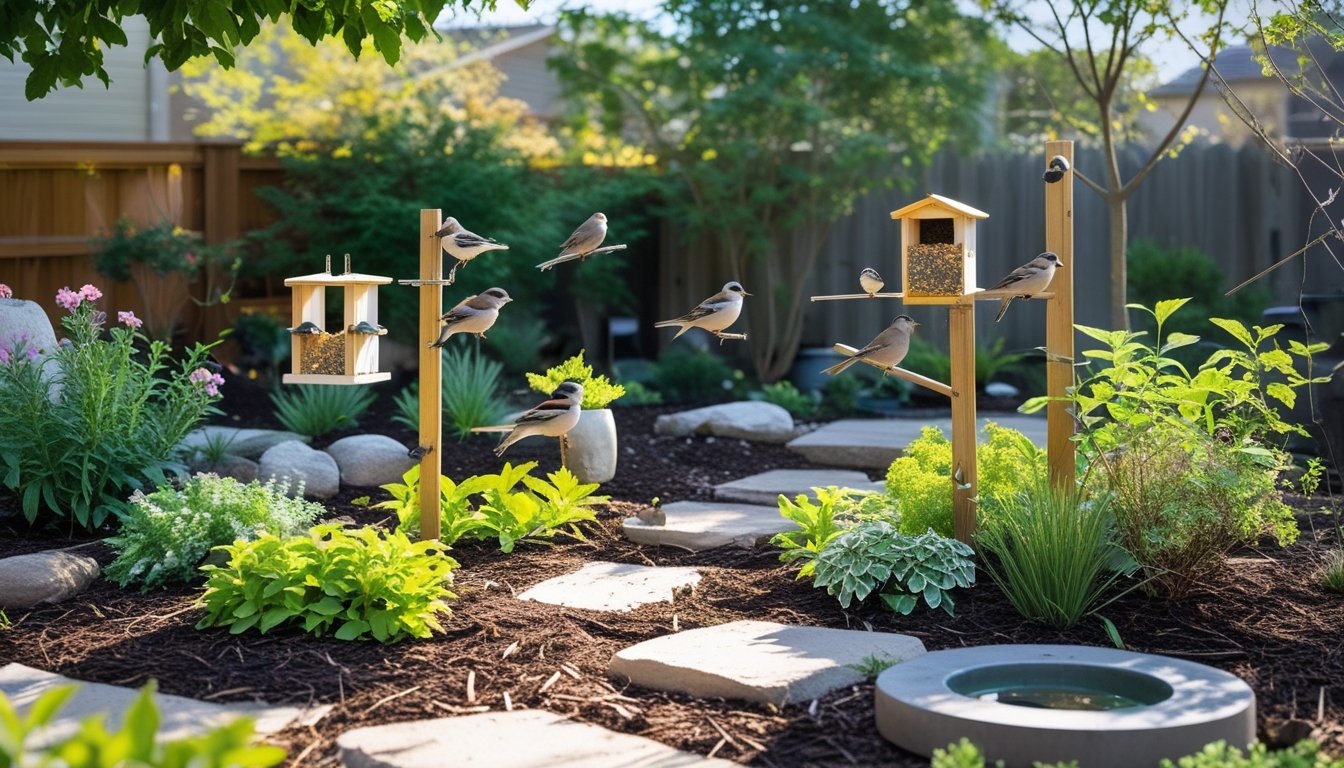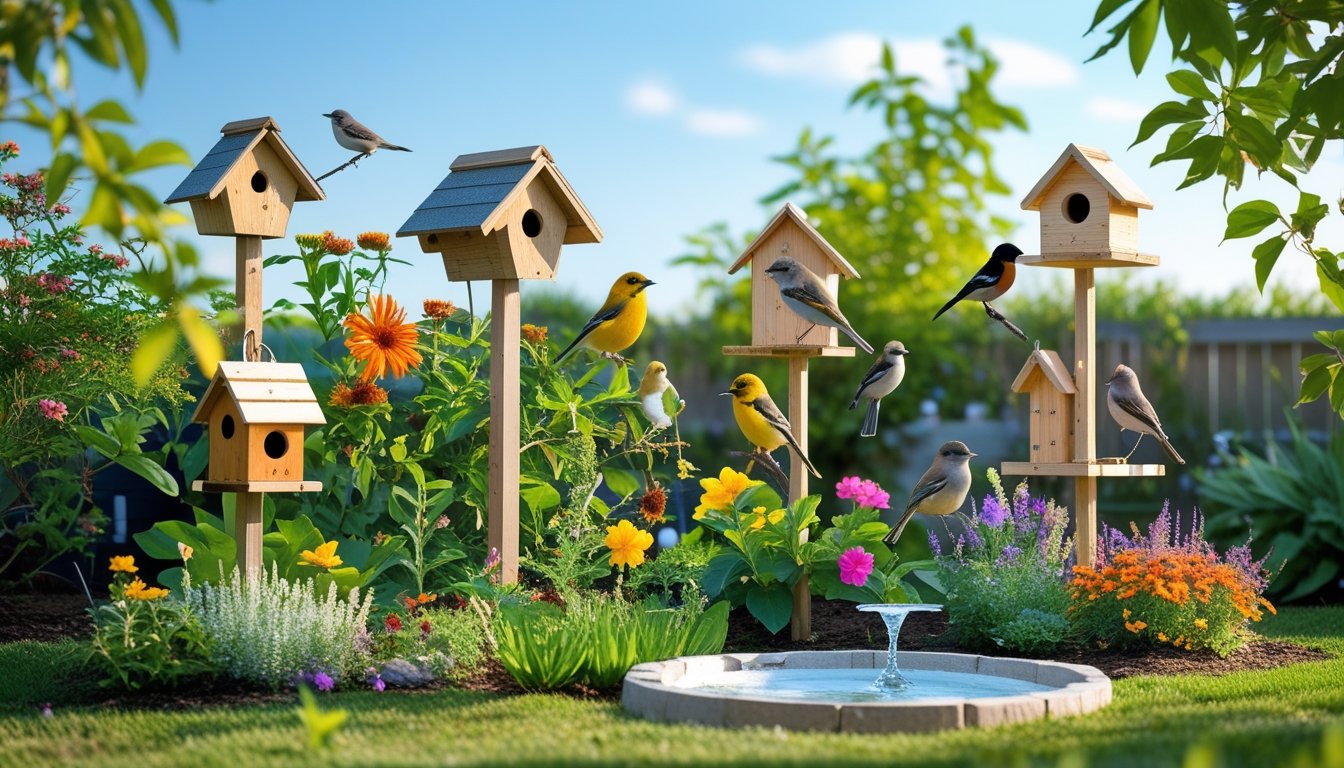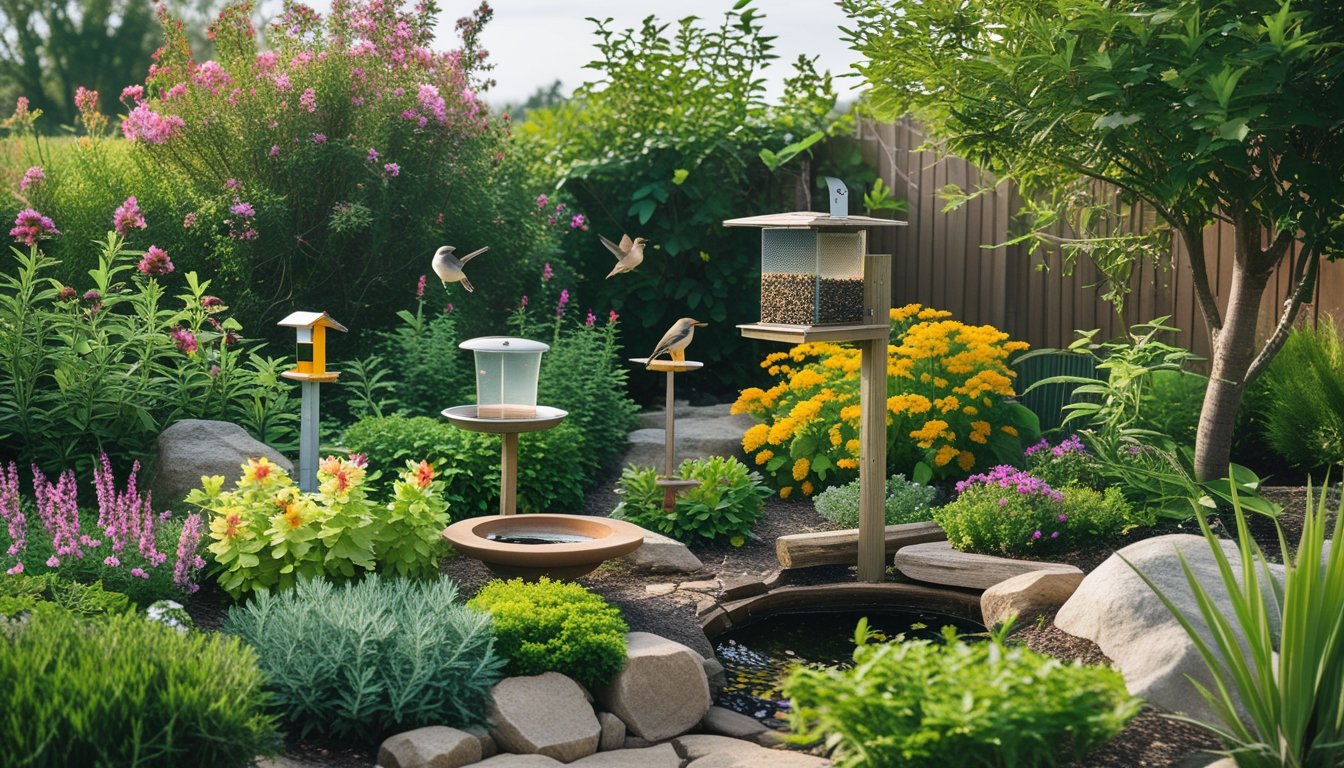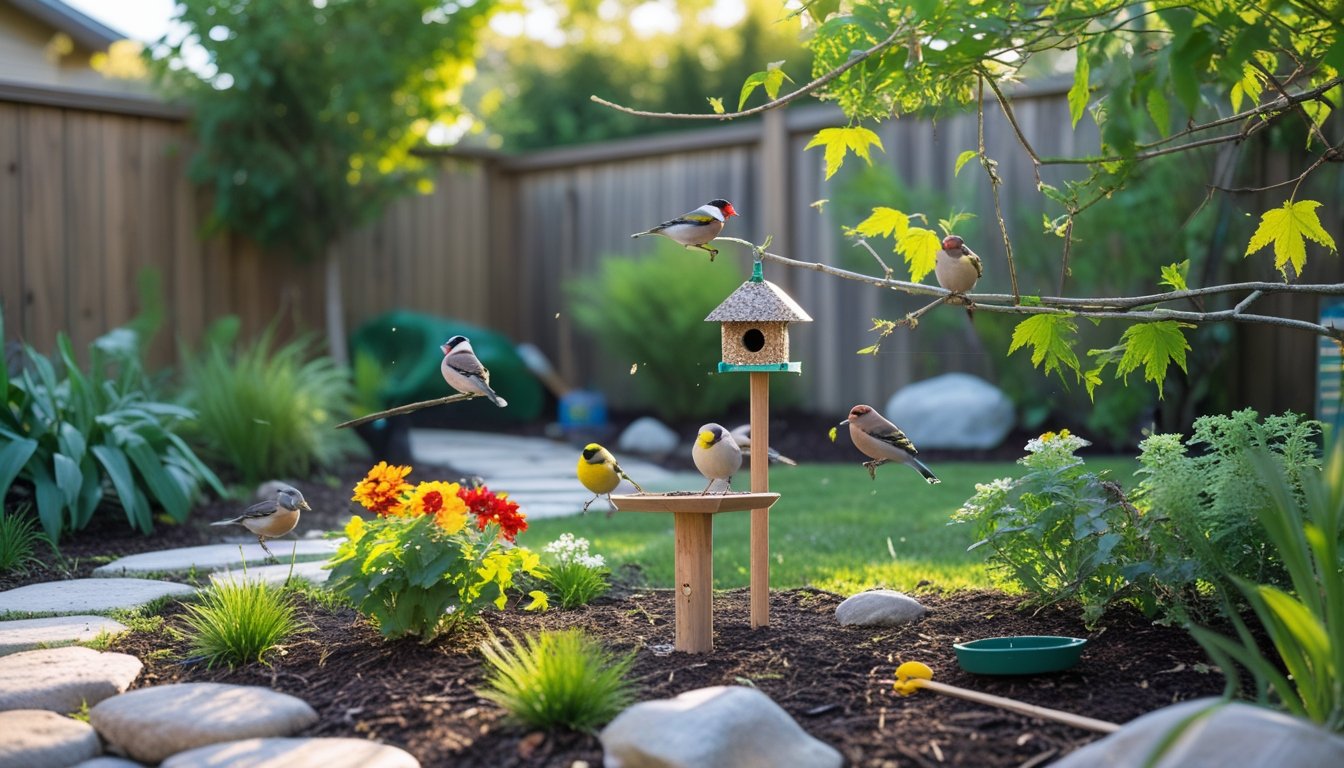Late updated: 26 May 2025 14:05
Written by: James Whitaker
Creating A Bird-Friendly Garden On A Budget: Tips for Nature Lovers
Creating a bird-friendly garden doesn't have to be an expensive undertaking. With thoughtful planning and a few strategic changes, we can transform our outdoor spaces into welcoming havens for our feathered friends. By incorporating native plants, providing water sources, and allowing parts of the garden to become natural habitats, we create an attractive environment for birds without breaking the bank.

Embracing biodiversity is key. Planting a mix of trees, shrubs, and flowers that provide shelter and food year-round can invite a variety of species. Leaving dead trees for nesting, setting up water features, and creating log piles are simple yet effective ways to enhance our garden's appeal to birds and other wildlife.
While the allure of a manicured garden is tempting, allowing a bit of wildness can be beneficial. By encouraging insects into our gardens, we naturally support the food chain and invite creatures that consume them. These steps create a balanced ecosystem that supports rich and diverse wildlife.
Key Takeaways
- Native plants and water sources attract birds and enrich gardens.
- Biodiversity improves wildlife value and supports various species.
- Simple, cost-effective changes create a bird-friendly environment.
Core Elements Of A Budget-Friendly Bird Garden

Creating a bird-friendly garden doesn’t have to be costly. By focusing on native plants, affordable food and water solutions, and low-cost shelter options, we can transform any backyard into a haven for birds without breaking the bank.
Choosing Native Plants On A Budget
Selecting native plants is essential for supporting local bird species. They offer the best sources of food and shelter while requiring less maintenance.
We should research plants that naturally thrive in our region’s climate. Local nurseries often have sales or even offer free seeds, which can help cut costs. Alternatives like community plant swaps are also a great way to acquire native plants without spending much.
Plants like wildflowers, shrubs, and small trees provide excellent habitats and food sources. By prioritising perennials, we can ensure longevity and reduce the need to replant each year. Additionally, grouping plants with similar water and sunlight needs can conserve resources and simplify gardening efforts.
Affordable Food And Water Sources
To attract birds, it’s crucial to provide accessible food sources. Homemade bird feeders can be constructed from materials like plastic bottles or wood scraps, making them cost-effective and customisable to specific bird species.
Supplementing natural food with seeds, nuts, and fruits can be economical when purchased in bulk. It's beneficial to include a bird bath or water source. Utilising a shallow dish or upcycled container ensures birds have access to fresh water, enhancing their visits.
Maintaining clean and filled water sources encourages frequent bird visitation and supports their health. Adding stones to the bird bath can provide perches, making it safer and more appealing.
Low-Cost Shelter And Nesting Opportunities
Crafting a welcoming environment with adequate shelter is vital. Low-budget ideas include using existing trees and shrubs to serve as natural cover. Leaving sections of the garden to grow wild can provide additional hiding spots and nesting materials.
Birdhouses are another affordable option, easily assembled from reclaimed wood. Placing these shelters at different heights can cater to various bird species. It’s important to position them away from high-traffic areas to minimise stress on the birds.
Encouraging birds to nest in the garden contributes to a vibrant ecosystem and offers them a safe space to raise their young, enriching our garden’s biodiversity.
Enhancing Biodiversity And Wildlife Value

Creating a bird-friendly garden not only attracts various bird species but also increases the area's biodiversity and overall wildlife value. By choosing the right plants and structures, we can support both birds and the broader ecosystem in sustainable and cost-effective ways.
Encouraging Insect Life And Natural Food Sources
One of the most effective ways to increase biodiversity is by encouraging insect life in our gardens. Insects like beetles, spiders, and caterpillars are crucial components of the food chain, feeding many bird species, including insectivores like robins.
We can create an insect-friendly environment by incorporating native plants such as purple coneflower and sunflowers, which offer nectar and pollen. A compost heap provides a haven for insects and boosts soil fertility. By allowing these natural processes, we maintain an environmentally balanced and thriving ecosystem.
Creating Habitats With Logs, Leaf Litter, And Ponds
Introducing small habitats can significantly enhance wildlife diversity. A simple woodpile or log stack offers shelter for hedgehogs and insects. Leaf litter left on the ground creates a natural cover and nutrient source, supporting a variety of small creatures.
Incorporating a pond adds another dimension, supporting frogs, newts, and attracting birds seeking water. Even a small pond can become home to diverse amphibians and insects. Together, these elements create a mosaic of microhabitats, increasing the garden's wildlife value.
Selecting Trees And Plants For Specific Birds
Our choice of trees and shrubs significantly impacts which birds visit our gardens. For instance, oaks, walnut, and cherry trees provide seeds, fruits, and insects that appeal to birds such as house finches and gold finches. These trees also offer nesting sites and protective cover.
Smaller plants, like sunflowers and purple coneflower, yield seeds that birds feed on during various seasons. By selecting plants that meet the dietary and shelter needs of specific bird species, we create a supportive and flourishing space for avian life.
Supporting Pollinators And Other Garden Wildlife
Pollinators like bees and butterflies play an essential role in any garden ecosystem. To support them, we should plant a variety of flowers that bloom at different times, ensuring that nectar is available throughout the growing season.
Creating a border with plants such as bee balm and milkweed attracts pollinators and provides food for their larvae. Beyond insects, small features like log refuges can support other wildlife, such as hedgehogs and amphibians, turning our garden into a sanctuary for numerous species.
By thoughtfully incorporating these elements, we invite a rich tapestry of wildlife into our gardens, enhancing biodiversity efficiently and affordably.
Frequently Asked Questions

Creating a bird-friendly garden on a budget involves smart choices about plants, feeders, and habitat materials. By using resources like recycled materials and native plants that naturally attract birds, we can establish a welcoming environment without overspending.
How can I attract birds to my garden without spending much money?
We can start by seeking help from friends who may have surplus garden items like plants, pots, or bird feeders. It's also possible to repurpose household items into feeders or baths, keeping costs minimal.
What types of plants are most beneficial for birds in a garden setting?
Native plants are ideal, as they provide natural food sources like berries, seeds, and nuts. They also require less maintenance, which helps cut down costs and create a sustainable habitat.
Can I create a bird bath using recycled materials, and how?
Yes, recycled materials like old pots, basins, or bowls can be repurposed into bird baths. Ensure these have a shallow depth and gently sloping sides. Regularly clean and refill with fresh water.
What are some effective strategies for protecting garden birds from predators?
Providing dense shrubs or thorny bushes for shelter helps protect birds. Installing barriers around feeding areas can discourage larger predators. It’s crucial to position feeders or baths away from spots where predators can easily access them.
Which budget-friendly foods can I provide to garden birds for optimal nutrition?
Birds enjoy seeds, oats, and fruits, all of which are affordable. Additionally, household leftovers like unsalted nuts and fruit scraps can also supplement their diet, contributing to their health without extra cost.
How can I ensure a bird-friendly garden throughout the different seasons?
Different plants thrive in each season, offering varied resources year-round. We can plant a mix of perennials and annuals to ensure consistent flora. Adjust food and water supplies as needed, especially during harsh seasons such as winter.
